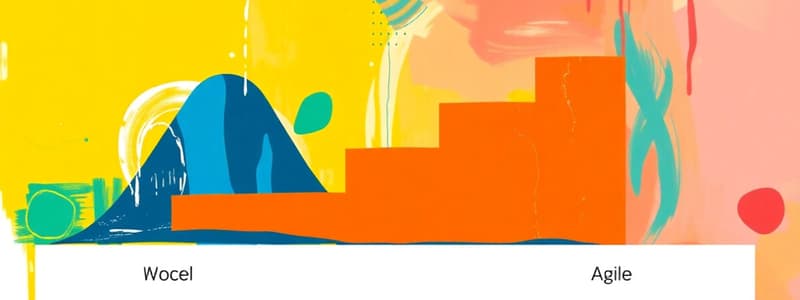Podcast
Questions and Answers
What is the primary focus of software specification in the development process?
What is the primary focus of software specification in the development process?
- Implementing code based on existing frameworks
- Designing user interfaces for software applications
- Understanding and defining the required services (correct)
- Testing the software for errors before release
In which model are process activities organized sequentially?
In which model are process activities organized sequentially?
- Incremental model
- Waterfall model (correct)
- Spiral model
- Agile model
Which of the following is not a part of the software development process?
Which of the following is not a part of the software development process?
- Software evolution
- Software testing (correct)
- Software specification
- Software design
What characterizes the software design process?
What characterizes the software design process?
Why must requirements be represented at different levels of detail?
Why must requirements be represented at different levels of detail?
What are the characteristics of a software process model?
What are the characteristics of a software process model?
Which process models are typically based on generic software process models?
Which process models are typically based on generic software process models?
What is a major weakness of the Waterfall Model?
What is a major weakness of the Waterfall Model?
What is an advantage of Incremental Development?
What is an advantage of Incremental Development?
What is a significant downside of Reuse-oriented Development?
What is a significant downside of Reuse-oriented Development?
Which statement accurately describes plan-driven processes?
Which statement accurately describes plan-driven processes?
What is a common misconception regarding Incremental Development?
What is a common misconception regarding Incremental Development?
Why is the Waterfall Model considered sequential?
Why is the Waterfall Model considered sequential?
What is the purpose of software verification and validation (V&V)?
What is the purpose of software verification and validation (V&V)?
What is the first stage in the three-stage testing process?
What is the first stage in the three-stage testing process?
Which type of maintenance is typically the most expensive to fix?
Which type of maintenance is typically the most expensive to fix?
What does iterative testing in software development help identify?
What does iterative testing in software development help identify?
What can cause defects to propagate during the software development process?
What can cause defects to propagate during the software development process?
What is a common reason for change in software development?
What is a common reason for change in software development?
What is one of the main aspects covered by environmental adaptation in software maintenance?
What is one of the main aspects covered by environmental adaptation in software maintenance?
What does a design output in Agile development usually represent?
What does a design output in Agile development usually represent?
Which process is described as an inevitable aspect of software?
Which process is described as an inevitable aspect of software?
What is the focus of system testing in the V&V process?
What is the focus of system testing in the V&V process?
Flashcards are hidden until you start studying
Study Notes
Software Process Models
- A simplified description of software process activities
- Represents activities from a particular viewpoint
- Includes sequence of activities, inputs/outputs, roles and responsibilities
- Acts as a roadmap for software teams
- Two categories: Plan-driven processes and Agile processes
Generic Software Process Models
- Based on paradigms: Waterfall Model, Incremental Development, Reuse-oriented Development
- Adapted and extended to create specific software process models
The Waterfall Model
- Aligns with system engineering process
- Provides complete documentation
- Weaknesses: inflexible to changing requirements, late discovery of technical problems, sequential nature
Incremental Development
- Manages evolving requirements effectively
- Identifies and resolves technical risks early
- Facilitates early customer feedback
- Weaknesses: reduced visibility and control, potential for poorly structured software
Reuse-oriented (Component-based) Development
- Advantages: lower development costs and time, reduced technical risk
- Disadvantages: compromises on requirements, less control over software evolution
Process Activities of Software Development
- Fundamental activities: specification, development, verification and validation, evolution
- Activities organized differently depending on the process model (e.g., sequential in Waterfall, interleaved and repeated in Incremental)
Process Activity: Software Specification
- Also known as requirement engineering
- Understands and defines required services
- Identifies constraints on service operation and development
- Represents requirements at different levels of detail
Process Activity: Software Development
- Divided into two parts: Software Design and Software Implementation
- Software Design: description of software structure (data models, interfaces, algorithms)
- Design is iterative with constant backtracking
- Software Implementation: converts design into executable system (manual implementation, model transformation, code-based design)
Process Activity: Software Development (Testing)
- Necessary for early defect detection
- Defects can occur at any level of design or implementation
- Defects can cascade during development
- Testing is iterative, as a change in one component may impact others
Process Activity: Software V&V
- Ensures system conformity to specifications
- Three-stage testing process: Component Testing, System Testing, Acceptance Testing
- Plan-driven processes use test plans to link testing and development
Process Activity: Software Evolution
- System changes after deployment
- Three types of maintenance: Fault repairs, Environmental adaptation, Functional addition
- Maintenance is iterative, with changes impacting other parts of the system
Coping with Change
- Change is inevitable in software development
- Causes: evolving requirements, business needs, technology advancements, new design and implementation approaches
- Adds development costs due to rework
Studying That Suits You
Use AI to generate personalized quizzes and flashcards to suit your learning preferences.





